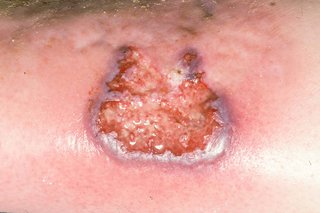Symptoms of pyoderma gangrenosum
The main symptom of pyoderma gangrenosum is a large, painful ulcer on your skin.
It usually starts as a small bump, spot or blood blister that gets bigger quickly and turns into an ulcer.
Sometimes you may have more than 1 ulcer.
Pyoderma gangrenosum ulcers:
- usually appear on the legs or chest
- may also appear around a cut or graze, a stoma (where part of your bowel is brought through an opening made in your tummy), or cuts from surgery
- may leak fluid


Other symptoms include:
- stiff joints
- aching and painful muscles
- a high temperature
If you're not sure it's pyoderma gangrenosum
Other conditions can have similar symptoms to pyoderma gangrenosum, such as venous leg ulcers, injuries to the skin, insect bites, skin tumours or infection.
Do not try to diagnose the problem yourself. See a GP if you're worried.
Non-urgent advice: See a GP if:
- you have a skin ulcer that's not getting better
Treatment for pyoderma gangrenosum
How pyoderma gangrenosum is treated depends on how severe it is.
It can take a long time for the ulcers to heal and you may have scars.
Treatment may include:
- creams or ointments
- bandages and dressings to protect the ulcer
- medicines to calm or control your body's immune system
- steroid injections
- antibiotics
Rarely, you may need surgery remove the ulcers.
Causes of pyoderma gangrenosum
It's not always clear what causes pyoderma gangrenosum. It may be an autoimmune disease, where the body's natural defence system (immune system) attacks healthy parts of your body.
It can also sometimes happen after an injury to the skin.
You may be more likely to get pyoderma gangrenosum if you have certain conditions, including:
- inflammatory bowel disease, such as ulcerative colitis or Crohn's disease
- rheumatoid arthritis
- certain blood disorders, such as myelodysplastic syndrome
- hepatitis
- Behçet's disease
You may also be more likely to get pyoderma gangrenosum if you take certain medicines.
Page last reviewed: 21 March 2024
Next review due: 21 March 2027
Images provided by DermNet.